Odekon M. Encyclopedia of paleoclimatology and ancient environments
Подождите немного. Документ загружается.

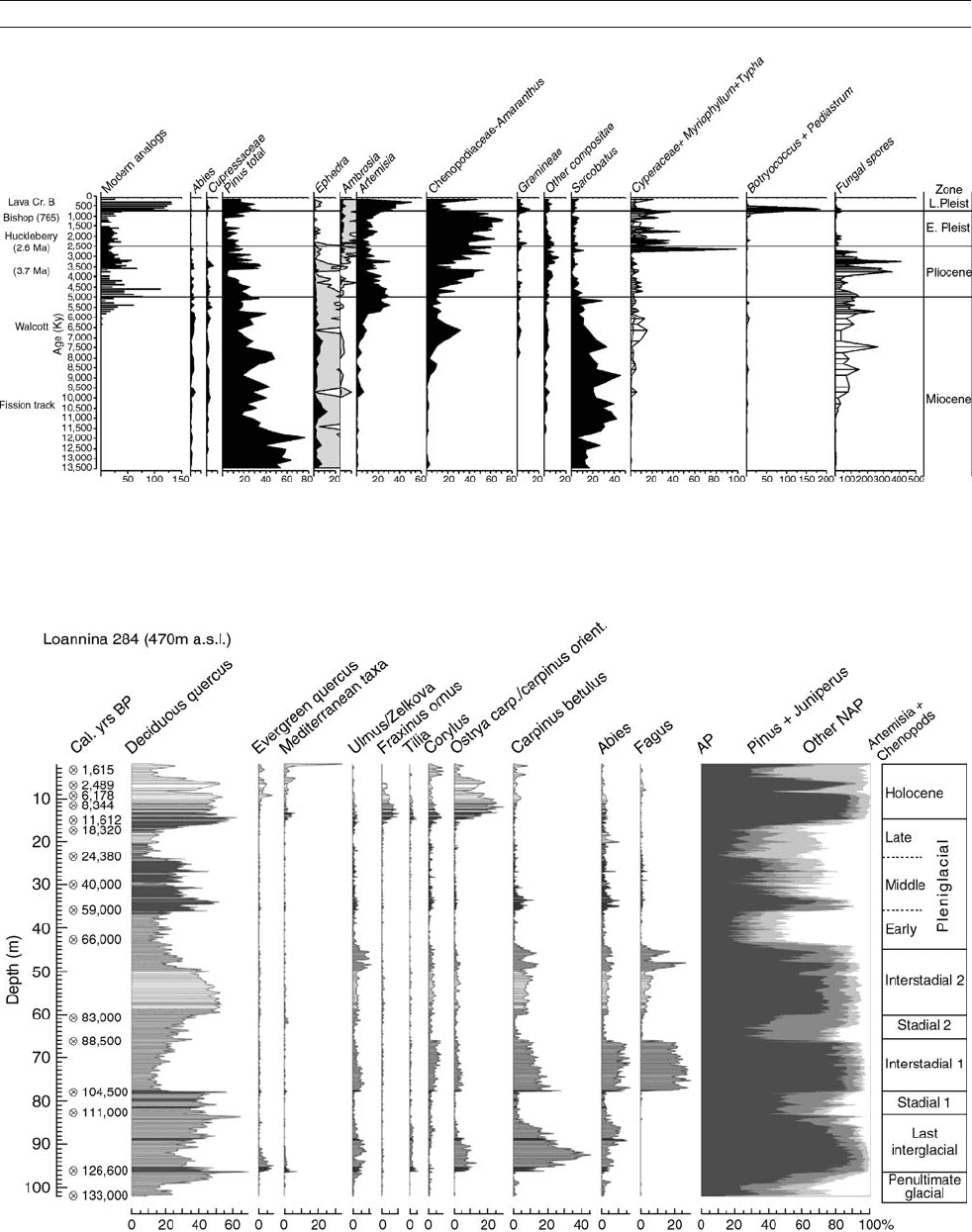
Figure P85 Pollen percentage diagram from borehole Ioannina 284. The spectra are presented as histograms connected by a sawtooth curve.
Depth is on the ordinate axis. Ages are given for specific points: the upper seven ages are calibrated radiocarbon ages, the lower ages are based on
astronomical calibration of pollen-vegetation abundance patterns (Tzedakis et al., 2002). Reprinted with permission from Tzedakis et al., 2002.
Copyright 2002 AAAS.
Figure P84 Percentage pollen diagram from Amoco Production Company’s Bridge well, Great Salt Lake. The volcanic ashes utilized for age control
are at the far left, along with a chronostratigraphic ordinate axis. The modern analog index has been plotted, along with ten common pollen
taxa utilized in the pollen sum. The shaded sawtooth curve for “Ephedra and Artemisia” represents a 10 exaggeration of the percentages.
“Cyperaceae + Myriophyllum + Typha” are wetland plants. “Botryococcus + Pediastrum” are algae. Geological time periods appear to the far right
(from Davis and Moutoux, 1998). Reproduced with permission from the author.
POLLEN ANALYSIS 821

often been used as biostratigraphic tools. The correlation of
zones amongst sites is a frequent point of discussion and con-
troversy in post-glacial pollen analysis, especially in Western
Europe. The recent increased utilization of radiometric dating,
most commonly radiocarbon applied to late Quaternary sedi-
ments, has somewhat replaced the reliance on zones for site-
to-site correlation.
Interpretation
The researcher is striving to interpret pollen assemblages and
their changes over time, or from one locale to another, as
changes in vegetation. “The vegetation is the central object in
pollen-analytic investigations” ... and yet there is “no one-to-
one correlation between the representation of a species in the
vegetation cover and in the pollen spectrum (Fægri et al.,
1989, p. 129).” Therefore, the soundest interpretations will
depend on the researcher’s knowledge of all the ecological and
geological factors that have affected the final pollen record.
The knowledge and skills required making a reasonable inter-
pretation of past vegetation and climate based upon a pollen
record will vary as greatly as the vegetation formations and
geological regimes encompassed by the pollen record.
Two common methodologies utilized to interpret the pollen
assemblages are the “modern analog” and the “indicator spe-
cies” methods. The modern analog method seeks to elucidate
the relationship between the vegetation that covers an area
and the pollen assemblage found at a point within that area.
Much field work has involved the collecting of small surface
sediment samples from within different types of vegetation for-
mations: the pollen are separated from the sediment, identified
with a microscope, and a spectrum of the identified pollen
taxa is produced; the surrounding vegetation is also identified
and classified. With sufficient samples, one can at least qualita-
tively correlate a pollen spectrum with a vegetation forma-
tion. Several complications arise: the existing array of pollen
surface samples is extensive in some vegetation types and not
others, the pollen surface samples are useful only insofar as
the vegetation (which produced the pollen) is in a state of
equilibrium with the environment (in all aspects), some impor-
tant geographical regions can yield no information on the
modern pollen-vegetation relationships since anthropogenic
activity has eliminated all the natural vegetation, and not
all pollen assemblages in the geological record have a modern
analog. However, in areas with adequate pollen surface sam-
ples, quantitative relationships between climate and pollen
may be attempted and the specialist literature contains exam-
ples of these (for a more detailed introduction see Bradley,
1999).
The indicator species method relies on the ecological or cli-
matological preferences of one (or a few) key taxa. If a taxon’s
habitat is highly specific, ecologically or climatologically, then
the presence of that single taxon may indicate the habitat, even
in the past. Alternatively, several taxa might be used to narrow
the climatic or ecological range of the spectrum. The indicator
species method is valid only if the fossil pollen truly indicates
the presence of the plant in the immediate vicinity of the
sampled site. Thus, application of this method should also utilize
modern pollen distribution studies showing correlations
between actual presence of a taxon, and a numerical pollen per-
centage threshold. The identification of plant macrofossils
(seeds, leaves, etc.) can substantiate a specific taxon’s presence,
which may be doubtful if based on pollen percentages alone.
Conclusions: examples of pollen records
The following examples show pollen analysis applied to late
Cenozoic sediments. The pollen taxa identified belong to extant
genera (or families) and hence interpretation may be based on
modern analogs and indicator species. Chronological resolution
varies with the basin cored; chronological control also varies,
from volcanic ashes to radiocarbon dates and to correlation
with marine records.
The longest continuous terrestrial sediment cores in North
America on which pollen analysis have been conducted come
from the Great Salt Lake, northern Bonneville Basin region
(northwest Utah; Davis and Moutoux, 1998; Davis, 2002).
Pollen analysis was conducted from sediment cuttings (which
integrate sediment from a range of depths) retrieved during
drilling conducted for geophysical exploration. The wells are
exceptionally deep, exceeding 3 km. The sampling interval is
from 3 to 30 m, and thus chronological resolution ranges from
8 to 23 kyr. The Bridge well (Figure P84) contains the longest
accumulation of pollen and sediments. The interpretation of the
relationship between vegetation and pollen spectra is based on
modern analogs; the fossil pollen samples were compared to
1,367 modern pollen samples from the western United States.
The squared chord distance metric statistical method, also
called square chord distance, was used to determine the ana-
logy between modern and the fossil pollen samples quantita-
tively. The environmental development of the Great Basin can
be interpreted from these pollen diagrams. Since the pollen
spectra were dominated by xerophytic vegetation, Sarcobatus
and Ephedra, from >5 Ma ago to the present, the region’s
present-day desert vegetation is interpreted to have existed
since the late Miocene. In addition, the poor pollen preserva-
tion and scarce pollen of wetland plants indicates that lakes
and marshes in the Great Salt Lake basin were shallow and
intermittent before 2.6 Ma. Between 5 and 0.75 Ma, the Sarco-
batus and Ephedra pollen are replaced by pollen from the
wetland plants, “Chenopodiaceae + Amaranthus” (these pollen
types are indicative of greasewood steppe vegetation), and
Artemisia (sagebrush), which indicates a regional cooling and
increase in moisture. After 0.75 Ma, Artemisia and Pinus pol-
len predominate, which is interpreted as downward displace-
ment of vegetation zones by approximately 500 m in
elevation, and the replacement of the greasewood steppe by
sagebrush steppe in the intermountain basins (Davis, 2002).
The Ioannina basin, Pindus Mountain Range, Greece, con-
tains a 430,000 year record of pollen in which fluctuating per-
centages can be used to understand the Quaternary climate
cycles and the reactions of tree populations (Tzedakis, 1993).
It provides a rare combination of stratigraphic continuity, and
high sedimentation accumulation rates for the late Quaternary.
Several lacustrine cores have been taken from the basin: the
increasing detail of the pollen analysis is evident, as the results
have been published. The first analysis shows the pollen
spectra alternating between forest and open vegetation com-
munities, reflecting the interglacial and glacial climate, res-
pectively. Four cycles are evident, and they are correlated
with glacial-interglacial changes registered in other southern
European pollen records. However, a unique feature of the Ioan-
nina cores is the continuous presence of Quercus and Abies,
followed by Pinus, Ulmus/Zelkova and, to a certain extent,
Corylus: these are temperate trees (Tzedakis, 1993). These
temperate tree populations persist even during glacial periods.
This record of the continuous presence of temperate tree
822 POLLEN ANALYSIS

pollen is used to support the ecological hypothesis that these
mountains provided long-term refugia for the temperate taxa
(Tzedakis, 1993).
Increased detail is apparent in the pollen analysis conducted
on a borehole called Ioannina 284 (Figure P85) (Tzedakis et al.,
2002, 2003). The mean sampling interval has been increased to
approximately 225 years. Because of the increased temporal
resolution of the record, greater detail within a single glacial
or interglacial becomes evident. The onset of the last intergla-
cial has been defined by the authors as occurring when tree pol-
len consistently rises above 50% frequency, and when tree
pollen concentration exceeds 200,000 grains per cm
3
; the onset
of the ensuing colder stadial occurs when tree pollen con-
sistently drops below 50%. Thus, the Last Interglacial is rep-
resented in the interval from 96.7 to 83.4 cm depth, or
approximately 127.3–111.7 kyr ago (Tzedakis et al., 2003).
After the chronology has been determined, the pollen changes
in Ioannina 284 are compared with other climatic data
from the North Atlantic region. The data indicate that the
millennial-scale expansions and contractions of tree popula-
tions may be in phase with climate events in the North Atlantic
region and Greenland regions. However, sufficient moisture to
maintain refugial temperate tree populations is proposed to be
linked to the topographic variability of the Pindus Mountains
(Tzedakis et al., 2002).
The pollen analyses from these two sites show how both
paleoclimatological and paleoecological interpretations may
be extracted from the studies. Furthermore, the means of chron-
ological control will vary with the age of the sediments. With
basins that encompass the Holocene epoch, laminated sedi-
ments may allow high temporal resolution. For older basins
(including marine sediments), age may be based on biostrati-
graphic correlations. Regionally significant climate changes
usually cannot be derived from a single pollen record: several
fossil pollen records together from a user-defined region are
necessary in order to confirm that patterns in pollen spectrum
have significance beyond the single site examined.
Margaret Kneller
Bibliography
Bradley, R.S., 1999. Paleoclimatology, Reconstructing Climates of the
Quaternary. Burlington, MA: Harcourt/Academic Press, 613pp.
Davis, M., 1969. Climatic changes in southern Connecticut recorded by
pollen deposition at Rogers Lake. Ecology, 50, 409–422.
Davis, O.K., 2002. Late Neogene environmental history of the Northern
Bonneville Basin: A review of palynological studies. In Hershler, R.,
Madsen, D.B., and Currey, D.R. (eds.), Great Basin Aquatic Systems
History. Washington, D.C.: Smithsonian Institution, pp. 295–307.
Davis, O.K., and Moutoux, T.E., 1998. Tertiary and Quaternary vegetation
history of the Great Salt Lake, Utah, USA. J. Paleolimnol., 19,
417–427.
Deevey, E.S., 1969. Coaxing history to conduct experiments. Bioscience,
19,40–43.
Erdtman, G., 1943. An Introduction to Pollen Analysis. Waltham, MA:
Chronica Botanica Company, 239pp.
Fægri, K., and Iversen, J., 1975. Textbook of Pollen Analysis, third revised
edition. New York: Hafner Press, 295pp.
Fægri, K., Kaland, P.E., and Krzywinski, K., 1989. Textbook of Pollen Ana-
lysis, by Knut Fægri and Johs. Iversen. Caldwell, NJ: The Blackburn
Press, 328pp.
McAndrews, J.H., Berti, B., and Norris, G., 1973. Key to the Quaternary
Pollen and Spores of the Great Lakes Region. Toronto, ON: The Royal
Ontario Museum, 64pp.
Pennisi, E., 2003. Modernizing the Tree of Life. Science, 300, 1692–1697.
Roberts, N., 1998. The Holocene: An Environmental History, 2nd edn.
Oxford, UK: Blackwell Publishers Ltd, 316pp.
Traverse, A., 1988. Paleopalynology. Winchester, MA: Allen & Unwin
Inc., 600pp.
Twell, D., 2000. Pollen: Structure, Development and Function. In Nature
Encyclopedia of Life Sciences. London, UK: Nature Publishing Group.
http://80-www.els.net.osiyou.cc.columbia.edu:2048 /[doi:10.1038 /npg.
els.0002039].
Tzedakis, P.C., 1993. Long-term tree populations in northwest Greece
through multiple Quaternary climatic cycles. Nature, 364, 437–440.
Tzedakis, P.C., Lawson, I.T., Frogley, M.R., Hewitt, G.M., and Preece, R.C.,
2002. Buffered tree population changes in a Quaternary refugium:
Evolutionary implications. Science, 297, 2044–2047.
Tzedakis, P.C., Frogley, M.R., and Heaton, T.H.E., 2003. Late Interglacial
conditions in southern Europe: Evidence from Ioannina, northwest
Greece. Glob Planet. Change, 367, 157–170.
von Post, L., 1967 [1916]. Forest tree pollen in south Swedish peat bog
deposits, a translation by M.B. Davis and K. Fægri of Om skogstrad-
spollen i sydsvenska torfmosselagerfoljder (foredragsreferat) (Geolo-
giska Foereningen i Skockholm. Foerhandlingar 38:384), with an
introduction by Knut Fægri and Johs. Iversen. Pollen et Spores,
9, 378–401.
Cross-references
Dating, Biostratigraphic Methods
Late Quaternary-Holocene Vegetation Modeling
Paleobotany
Palynology
Quaternary Vegetation Distribution
POTASSIUM-ARGON/ARGON-ARGON DATING
General principl es
The K-Ar dating method utilizes the decay of the naturally-
occurring radioactive isotope of potassium,
40
K, into an isotope
of the noble gas, argon (i.e.,
40
Ar).
40
K decays into two different
daughter products: the most common path (89.5%) is via beta
decay into
40
Ca; the remainder of the decay paths arrive at
40
Ar, mostly via electron capture, but also rarely via positive
beta (positron emission) decay. The total decay half life for
40
K is about 1.25 billion years, which means that there is still
some of the isotope remaining from the formation of the solar
system. Because of the branching decay scheme, the standard
radiometric age equation needs to be modified as follows:
t ¼
1
l
ln 1 þ
l
l
e
40
Ar
40
K
ð1Þ
where l
e
is the decay constant leading to
40
Ar (0.581 10
10
yr
1
) and l is the total decay constant for both branches
(5.543 10
10
yr
1
).
Much of the natural radioactivity surrounding us is due to
40
K, but fortunately, it is a quite rare isotope, only accounting
for about one atom in 8,570 atoms of potassium. Despite the
rarity of
40
K and the fact that only about one atom in ten decays
into
40
Ar, the K-Ar system is arguably the most versatile of the
long-lived decay scheme dating methods. It is nearly an ideal
chronometer because K is a major element present in almost
all rocks and minerals, but the act of mineral formation is
usually exceptionally efficient at excluding atmospheric argon
from the mineral’s crystal structure. Radiogenic
40
Ar is well
POTASSIUM-ARGON/ ARGON-ARGON DATING 823

accommodated in many minerals, which can often quantita-
tively retain their Ar to temperatures of 300–400
C or higher.
Therefore, K-Ar dating usually has a very clear-cut resetting of
the radiometric clock and the clock can faithfully record geolo-
gical time for durations ranging from thousands to billions of
years. Indeed, K-Ar and its cousin Ar-Ar dating have been used
successfully to calibrate all of the geomagnetic reversal time
scale, much of the history of early humanity, and most of the
Phanerozoic timescale, plus ancient samples from Earth, the
Moon and Mars.
K-Ar method
In the conventional K-Ar dating method, a part of the sample is
analyzed via wet chemistry techniques for K concentration; the
remainder of the sample is placed into an ultra-high vacuum
system and fused to release all of its trapped gases. The
released water vapor is usually trapped in a “cold trap” at dry
ice or liquid N
2
temperatures, and the remaining active gases
are removed using a “getter” pump, which consists of a highly
reactive metal alloy kept at an elevated temperature. The getter
removes O
2
,N
2
,CO
2
,CH
4
, etc., but leaves the Ar untouched.
The remaining “cleaned” Ar sample is usually mixed with a
known quantity of the rare argon isotope
38
Ar so that the con-
centration of
40
Ar can be estimated from the
40
Ar/
38
Ar ratio
(i.e., isotope dilution). The combined Ar sample is then
admitted to a noble gas mass spectrometer. The presence of
any atmospheric Ar is corrected by monitoring the
36
Ar signal
and subtracting an amount 295.5 times larger from the
40
Ar
peak (i.e., the
40
Ar/
36
Ar ratio of the atmosphere).
The precision of the K-Ar method is limited by the errors
associated with the isotope dilution technique, weighing errors,
and the precision of the chemical measurement of K concentra-
tion. Typical error estimates are about 1–2% for this method.
Accuracy and the reliability of K-Ar ages are further hampered
by so-called “nugget effects,” where there may be unusual
phases in either the K or Ar sample split. This possibility and
the requirement for two separate measurements limit the use
of the technique to relatively large and homogeneous samples.
Ar-Ar or the
40
Ar/
39
Ar method
In 1966, the team of Merrihue and Turner, working in John
Reynold’s laboratory, devised a remarkable enhancement of
the K-Ar method that has greatly increased its scope and power
(Merrihue and Turner, 1966). In the
40
Ar/
39
Ar (or Ar-Ar) dat-
ing method, a single split of the sample is sent to a nuclear
reactor and irradiated with high-energy neutrons. Some of the
most common isotope of potassium, the stable isotope
39
K,
undergoes a reaction where it briefly absorbs a neutron and
expels a proton, thereby transforming into
39
Ar. This isotope
of argon is radioactive and is not present in the atmosphere in
appreciable quantities since it has a half-life of only ca. 270
years. The sample now has both its original radiogenic
40
Ar
and another argon isotope, which can effectively be used as a
proxy for potassium. It is possible to measure the
40
Ar/
39
Ar
ratio, which is proportional to the
40
Ar/K ratio, which is in turn
proportional to the
40
Ar
/
40
K ratio. The proportionality constant
is estimated by analyzing a standard mineral of known K-Ar
apparent age during the same neutron irradiation as the sample.
The
40
Ar/
39
Ar age equation can be written as:
t ¼
1
l
ln 1 þ J
40
Ar
39
Ar
K
ð2Þ
The superscript * denotes radiogenic
40
Ar. J is calculated as:
J ¼
e
lt
standard
1
40
Ar
=
39
Ar
K
ðÞ
standard
ð3Þ
The suffix “K” is put on
39
Ar to indicate that only the com-
ponent from potassium is used. There are interfering nuclear
reactions, usually from Ca, which produce small amounts of
36
Ar and
39
Ar, but these can be corrected by calibration ana-
lyses of pure Ca salts. Ca also produces significant quantities
of the radioactive isotope
37
Ar and it is possible to infer the
relative concentrations of Ca, Cl, and K by the enhanced abun-
dances of
37
Ar,
38
Ar, and
39
Ar, respectively.
The
40
Ar/
39
Ar method eliminates the problem of sample het-
erogeneity and it has significantly better precision relative to
K-Ar dating because all of the measurements are based on iso-
tope ratio measurements, not absolute concentration estimates,
and mass spectrometers are much more accurate with the for-
mer style of measurement. Age estimates that are precise to
within a few tenths of a percent are commonplace, but even
more important than laboratory precision are the extra interpre-
tation capabilities of the technique, which lead to more accurate
age estimates.
Since age information comes from Ar isotope ratios, it is
possible to step-heat a sample in gradually increasing tempera-
ture steps and calculate an apparent age for each gas fraction.
The sequence of apparent ages is plotted as an “age spectrum,”
which can be extremely useful in testing whether or not the
sample has remained a closed system during its lifetime. Ideally,
the age spectrum will yield a flat sequence of ages or a perfect
“plateau age” which can be used with much greater confidence
than a comparable single K-Ar age. Alternatively, there are
other typical age spectral patterns such as that expected from
diffusive loss of Ar or the so-called “saddle shaped” spectrum,
which is diagnostic for the presence of excess
40
Ar. Sometimes
it is possible to derive useful age information event from these
disturbed age spectra (e.g., Snyder et al., 1996), but at the very
least a disturbed age spectrum is a red flag indicating that the
data need to be interpreted with care.
40
Ar/
39
Ar step-heating also makes it possible to do an iso-
chron style analysis on a single sample, which was impossible
with the K-Ar method. Usually in an argon isochron diagram,
the
36
Ar/
40
Ar ratio is plotted against the
39
Ar/
40
Ar ratio, and the
intercepts of the fitted line indicate the sample’sinitial
36
Ar/
40
Ar
ratio and apparent age. This kind of analysis is particularly useful
for young samples (a few Ma) where the usual assumption of
atmospheric composition initial Ar can be rigorously tested.
Finally, the combination of
40
Ar/
39
Ar dating with a new
generation of low-blank laser fusion systems (York et al.,
1981) and high sensitivity mass spectrometers has led to a
whole generation of highly automated laboratories capable of
routinely analyzing extremely small and extremely young sam-
ples. A crucial application has been to revolutionize the dating
of volcanic tephra (Lo Bello et al., 1987) by enabling the
researcher to date single crystals of volcanic feldspar, thereby
eliminating contamination problems, which had long plagued
bulk sample analyses. This in turn has allowed for extremely
accurate ages for studies ranging from calibrating the geomag-
netic reversal timescale to dating early human specimens. For a
more complete description of the
40
Ar/
39
Ar method, see
McDougall and Harrison (1999).
Chris M. Hall
824 POTASSIUM-ARGON/ ARGON-ARGON DATING

Bibliography
Lo Bello, P., Fraud, G., Hall, C.M., York, D., Lavina, P., and Bernat, M.,
1987.
40
Ar/
39
Ar step-heating and laser fusion dating of a Quaternary
volcanic from Neschers, Massif Central, France: The defeat of xeno-
crystic contamination. Chem. Geol. (Isotope Geosci.), 66,61–71.
McDougall, I., and Harrison, T.M., 1999. Geochronology and thermochronol-
ogybythe
40
Ar/
39
Ar method. New York: Oxford University Press, 269pp.
Merrihue, C., and Turner, G., 1966. Potassium-argon dating by activation
with fast neutrons. J. Geophys. Res., 71, 2852–2859.
Snyder, G.A., Hall, C.M., Lee, D.-C., Taylor, L.A., and Halliday, A.N.,
1996. Earliest high-Ti volcanism on the moon:
40
Ar-
39
Ar, Sm-Nd and
Rb-Sr isoptopic studies of Group D basalts from the Apollo 11 landing
site. Meteoritics, 31, 328–334.
York, D., Hall, C.M., Yanase, Y., Hanes, J.A., and Kenyon, W.J., 1981.
40
Ar/
39
Ar dating of terrestrial minerals with a continuous laser. Geo-
phys. Res. Lett., 8(11), 1136–1138.
Cross-reference
Dating, Radiometric Methods
PRECESSION, CLIMATIC
The celestial equator intersects the ecliptic in two points. The ver-
nal equinox is the one at which the Sun in its apparent annual
motion crosses from South to North of the equator. The vernal equi-
nox can be used as a reference point to define the celestial longitude
locating the Earth along its orbit during the year. The longitude of
the perihelion (ϖ) represents the angular position of the perihelion
of the orbit from the vernal equinox. This angle gives the position
of the Earth on its orbit at the spring equinox. Knowing the longi-
tude of the perihelion, it is possible to determine the Earth-Sun dis-
tance at any time in the year. Climatic precession (e sin ϖ)is
usually used instead of the longitude of the perihelion. It is the main
factor driving the 24 h-mean irradiance.
Astronomers of old civilizations kept records of the direc-
tion of the Earth’s axis of rotation in the sky. Five thousand
years ago, stars circled around a-Draco’s in the night sky, while
it is now around a Ursa Minor (polaris). Indeed the Earth’s axis
of rotation does not point towards a fixed direction through
time but describes a clockwise circle in space. This happens
because the torque of the Moon and the Sun on the Earth’s
equatorial bulge causes the axis of rotation to wobble (the
Earth’s equatorial radius is close to 6,375 km while its polar
radius is only 6,355 km). This motion of the Earth’s axis
of rotation, called astronomical precession, is similar to the
precession of a tilted top and it induces the motion of the vernal
equinox, with a period of 25,700 years. However, from a paleo-
climatic point of view, the situation is not so simple. Indeed,
the ecliptic is not fixed in time either, leading to an anticlock-
wise motion of the perihelion. Consequently the climatic pre-
cession, which describes the position of the perihelion with
respect to the vernal equinox, varies with a quasi-period of
21,000 years, resulting from the combination of several peri-
ods, the most important being around 23,000 and 19,000 years
(Berger, 1978; Berger and Loutre, 1991) (Figure P86).
The present-day value of the longitude of the perihelion is
ϖ = 102.04
, which gives a climatic precession of e sin
ϖ = 0.01636. In this situation the Earth is at the closest dis-
tance to the Sun in early January (Berger and Loutre, 1994).
Therefore the mean solar irradiance received during the south-
ern summer in the Southern Hemisphere is larger than the mean
solar irradiance received during the boreal summer in the
Northern Hemisphere. Some 11,000 years ago, the Earth
was at the closest distance to the Sun around the June solstice.
This increased the solar irradiance received during boreal sum-
mer and reduced it during Southern Hemisphere summer. The
climatic precession therefore plays opposite roles in both hemi-
spheres. Any insolation change in one hemisphere due solely
to a variation in climatic precession corresponds to an insola-
tion change of opposite sign and same amplitude in the other
hemisphere six months later (Figure P87).
Moreover, the length of the seasons, which vary in time
according to Kepler’s law, is also strongly dependent on the
climatic precession (Berger and Loutre, 1994). Presently the
length of the Northern Hemisphere seasons is respectively
92.8 days for spring, 93.6 days for summer, 89.8 days for
autumn, and 89 days for winter. In about 4,500 years from
now, the Northern Hemisphere spring and winter will have
about the same short duration (89.6 days), and summer and fall
will also be equally long (93.0 days).
Marie-France Loutre
Bibliography
Berger, A.L., 1978. Long-term variations of daily insolation and Quatern-
ary climatic changes. J. Atmos. Sci., 35(12), 2362–2367.
Berger, A., and Loutre, M.F., 1991. Insolation values for the climate of the
last 10 million years. Quaternary Sci. Rev., 10, 297–317.
Berger, A., and Loutre, M.F., 1994. Precession, eccentricity, obliquity, inso-
lation and paleoclimates. In Duplessy, J.C., and Spyridakis, M.-T.
(eds.), Long Term Climatic Variations, Data and Modelling, vol. 22.
Nato ASI series, Serie I: Global Environmental Change, Berlin:
Springer, pp. 107–151.
Figure P86 Long-term variations of the climatic precession over the last 800,000 years.
PRECESSION, CLIMATIC 825
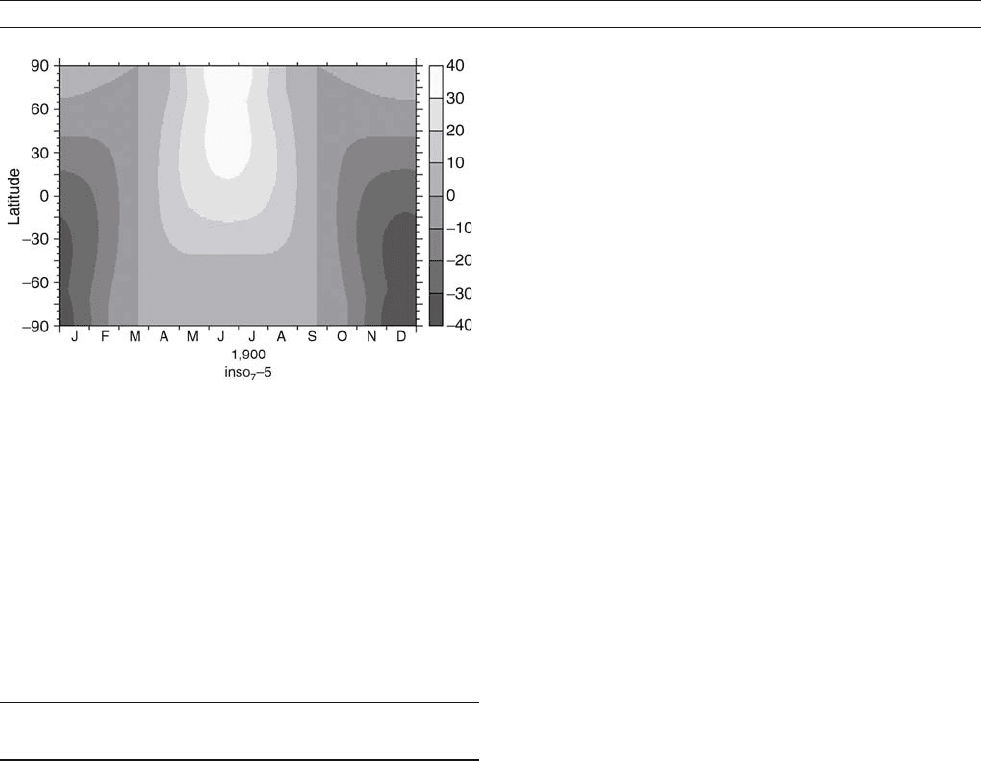
Cross-references
Astronomical Theory of Climate Change
Climate Forcing
Eccentricity
Obliquity
Pre-Quaternary Milankovitch Cycles and Climate Variability
Quaternary Climate Transitions and Cycles
SPECMAP
PRE-QUATERNARY MILANKOVITCH CYCLES AND
CLIMATE VARIABILITY
Introduction
Cyclic variations in insolation, caused by the precession and
obliquity of Earth’s spin axis and variations in the eccentricity
of Earth’s orbit, have been stressed as a driver of Quaternary cli-
mate since Hays et al. (1976). The Quaternary, however, com-
prises only 0.4% of Earth history, and is characterized by
unusual “ice house” conditions. In addition, neither the mechan-
ism through which ice house conditions were initiated, nor the
mechanism whereby the 100 kyr cycle has come to dominate
glacial oscillations are understood (see Muller and MacDonald,
2000). Analysis of pre-Quaternary Milankovitch cycles provides
a more synoptic view of the role of astronomically controlled cli-
mate change, a context for understanding the present state of the
Earth system and anthropogenic modifications, a mechanism for
producing high-resolution timescales, and data for calibrating the
dynamic evolution of the solar system (see reviews by Berger
et al., 1989; Fischer et al., 1991; Schwarzacher, 1993; Weedon,
1993, 2003;Hinnov,2000, 2005).
Methods
Two fundamentally different, although mutually illuminating,
approaches to the analysis of pre-Quaternary Milankovitch
cyclicity have been developed. The first, cycle counting, pre-
dates acceptance of the Milankovitch theory for Quaternary
climate change by nearly a century (e.g., Gilbert, 1895)
(Figure P88). Cycle counting is an inherently typological
approach requiring both identification of each sedimentary or
proxy cycle and its boundaries within a section and a timescale
to determine cycle duration. Bundles of cycles of variable thick-
ness allow recognition of the characteristic Milankovitch cycle
hierarchy based on the thickness ratio of short to long cycles,
assuming the highest frequency cycles have been correctly iden-
tified. A variant of the cycle counting approach is named for
Fischer’s(1964) analysis of the Triassic asymmetric carbonate
Lofer cycles (Figure P89). These so-called Fischer plots are
graphs of cumulative departure from average cycle thickness
plotted against cycle number, assuming a uniform period for
each cycle and modified for assumed constant subsidence during
each cycle (see Sadler et al., 1993; Boss and Rasmussen, 1995
for criticism). While the typological cycle counting method
allows easy visualization of sedimentological patterns and cycle
identification in the field, the numerous ad hoc assumptions that
must be made about the variability of the cyclicity makes its
practical use treacherous unless there is a known target pattern
for correlation, such as an age-appropriate and accurate insola-
tion curve. Additionally, often used as a measure of relative
sea-level change, Fischer plots appear to be a poor predictor
for Quaternary examples where sea-level change is well under-
stood (e.g., Boss and Rasmussen, 1995).
The second approach, time series analysis, is commonly
used in Quaternary analyses and was inspired by the pivotal
paper by Hays et al. (1976) that established Milankovitch cycli-
city as the “Pacemaker of the Ice Ages, ” although there were
earlier applications. Here, a variable (lithological or climate
proxy) is plotted against thickness or time, and Fourier or other
quantitative methods are used to determine the frequency prop-
erties of the data that can then be compared to a hypothesis of
orbital forcing (Figure P90). This method dispenses with the
need to identify the cycle type, has the advantage of not requir-
ing variability in the data to be discarded, and thus does not
presume the mode of cyclicity (i.e., precession vs. obliquity).
The disadvantage is that the variable must have a unimodal
relationship to climate or a precise timescale must be available;
these become progressively much less common in more ancient
deposits. Sequences have typically been analyzed by Fourier
methods with the data transformed from the depth or time
domain to the frequency domain. The results are usually
expressed as a periodogram (a graph of frequency against a
measure of the importance of that frequency, such as power).
This method, however, presumes little variation in accumula-
tion rate; that is, the frequencies are stationary with respect to
the depth scale. This assumption can be considerably relaxed
with use of evolutive or depth-frequency analysis. Here, the
frequency properties of the section are analyzed by use of
a moving window and are plotted with respect to depth
(Figure P91). A plethora of techniques is available in which
accumulation rate changes can be determined directly from
the internal frequency properties of the data.
Timescales
Both cycle counting and time series methods require a time-
scale to help assess accumulation rates. Accumulation rates
are quantified by relying largely on direct dating by annual
rhythms (varves) and radiometric methods, indirect dating by
correlation to other well established timescales, such as d
18
O
curves or magnetic polarity transitions, and tuning to insolation
curves based on celestial mechanics. In older stratigraphic
Figure P87 Variation of the mean irradiance (W m
2
) following a
change in the climatic precession from perihelion at winter solstice to
perihelion at summer solstice (at present-day eccentricity, e = 0.0167
and obliquity, e 23.446
.
826 PRE-QUATERNARY MILANKOVITCH CYCLES AND CLIMATE VARIABILITY
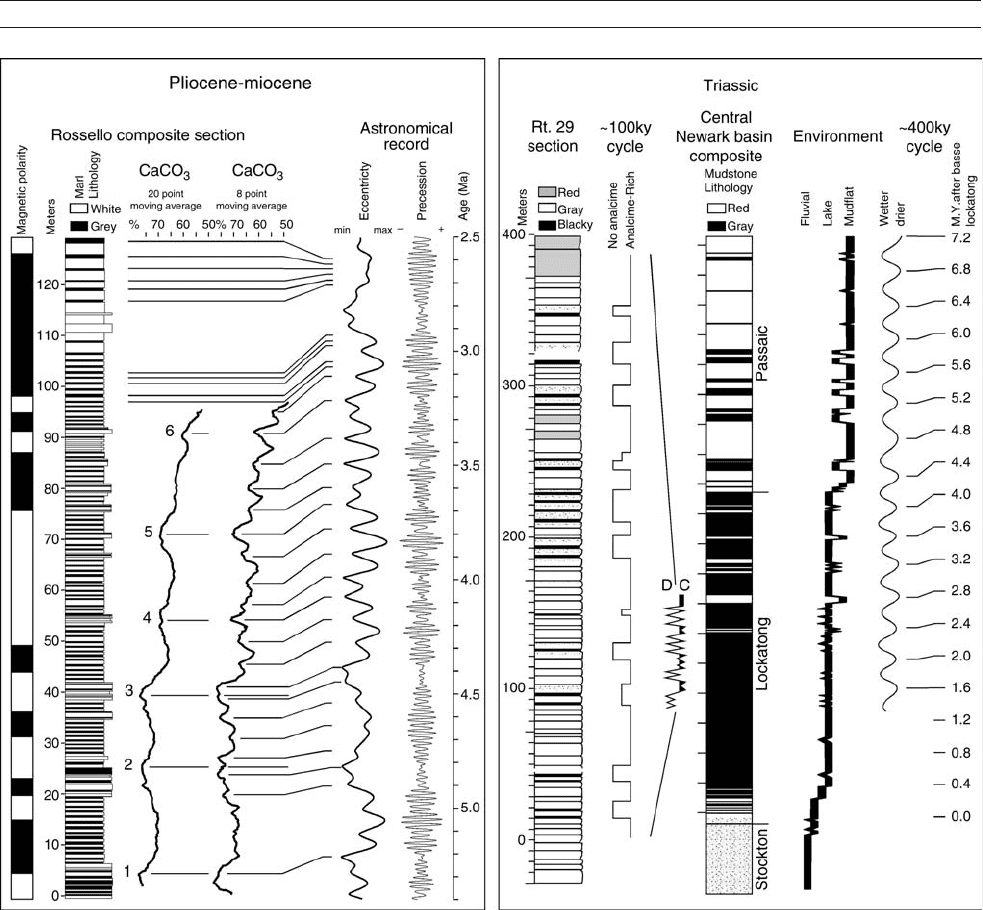
records, it becomes progressively harder to apply these proxies
and dating methods successfully and other, more inferential,
methods must be used.
Varves are annual rhythms that can be marine or non-marine
and generally consist of couplets or, more rarely, of triplets
of heterogeneous laminae (see review by Anderson, 1964;
Anderson and Dean, 1988). It is usually assumed that a single
couplet or lamina series represents one year, corresponding to
summer and winter or wet and dry seasons, although some
lacustrine environments could theoretically possess two cou-
plets of laminae series per year, and there can be confusion
with tidal banding. Although varve calibration provides direct
and very high-resolution records of accumulation rates, varved
sequences are rare and when present often constitute only a
small part of the sedimentary column.
Radiometric dates provide another direct way to calibrate
accumulation rates and a basis for a timescale. To be useful,
there must be several dates in a section separated in time
sufficiently to exceed error limits, and they must be geologically
accurate. Very few sections meet these criteria. It is possible
to obtain paleontological or other time-correlative means to
tie radiometric dates to sections under analysis. Possible difficul-
ties are exemplified by debates on the Triassic Latemar and
the Eocene Green River Formation (Hinnov and Goldhammer,
1991; Brack et al., 1996; Pietras et al., 2003; Machlus
et al., 2004, 2008).
As is true for Quaternary records, the relatively well-estab-
lished marine d
18
O record provides a powerful tie to published
timescales for older Neogene marine sections (e.g., Miller et al.,
1987). The temporal accuracy, however, of correlations to the
Figure P88 Cycle counting and matching to an astronomical record; left: marine Pliocene-Miocene example with astronomical calibration from
Sicily modified from Hilgen (1991b); right: lacustrine Triassic example, modified from Van Houten (1964) with 400 kyr cycle added.
PRE-QUATERNARY MILANKOVITCH CYCLES AND CLIMATE VARIABILITY 827
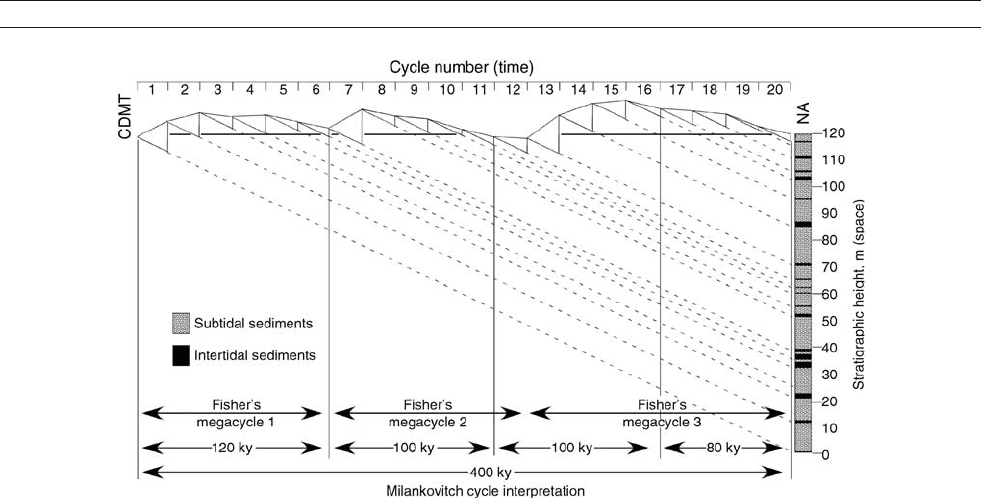
d
18
O record can be no better than the accuracy of the d
18
O
record itself, which is undergoing significant modifications.
Using this technique for accumulation rate calibration, only
open marine sections can be meaningfully correlated, and the
section being correlated needs sufficient temporal scope to
encompass enough of the character of the d
18
O curve.
Correlation and tuning to insolation curves has been exten-
sively used in strata of Neogene age, but less commonly in
the Paleogene (e.g., Hilgen, 1991a,b; Shackleton et al., 2000),
and not at all in the Mesozoic and older strata (Figure P88).
The production of insolation curves to which ancient proxy
curves can be matched is limited by uncertainties in observa-
tions, chaotic behavior of the planets, lack of knowledge of the
evolution of the Earth-Moon system, and dynamic aspects of
mass distribution within the Earth. Insolation curves for the
higher frequency climatic precession and obliquity cycles are
accurate to 40–50 Ma, and the 405 kyr cycle to 250 Ma. The
variations of the 405 kyr cycle beyond 250 Ma are relatively
small, and could be used, recognizing the larger uncertainties,
back to the age of the Earth (see Laskar, 1990, 1999; Berger
et al., 1992;Laskaretal.,1993, 2004; Palike et al., 2004). If
the 405 kyr cycle can be identified, it can be used to calibrate
average accumulation rate and hence provide a mechanism to
establish the period of higher frequency cycles independent of
their drift through deep time (e.g., Olsen and Kent, 1999).
For the late Jurassic through Neogene, the well-established
marine magnetic anomaly timescale (Cande and Kent, 1995)
establishes broad constraints for sections with internal polarity
data. Although the average duration of a chron is ~0.25 million
years (Lowrie and Kent, 2004), correlation to the marine mag-
netic anomaly timescale is useful only for sections involving
millions of years. As there is no marine magnetic anomaly
timescale for strata older than late Jurassic, Milankovitch
cycles have proved more useful for calibrating the magnetic
polarity record than vice versa (e.g., Kent and Olsen, 1999).
One of the most powerful methods of calibrating accumula-
tion rate is via the internal frequency structure of the data series
itself, and this takes two basic forms. First, the celestial
mechanical theory predicts a very specific relationship between
the higher and lower frequencies present in data. The lower fre-
quencies are beat cycles of the higher frequencies within the
precession-related bands or the obliquity-related bands. The
frequencies of the ~100 kyr eccentricity cycles are equal to
the differences between the frequencies of the climatic preces-
sion cycles because these cycles result from the interaction of
the Earth’s precession and the gravitational attraction of the
planets and the eccentricity cycles result from the gravitational
interaction of the very same planets. At present, the main peri-
ods that can be recognized in climatic precession are about 19,
23, and 24 kyr. The periods of the linear combinations of dif-
ferences of the frequencies of these periods are about 93,
125, and 405 kyr (calculated using appropriate precision). This
is a mathematical relationship that holds regardless of changes
in the value of the precession constant in the deep past (due
to the Earth-Moon system evolution or mass distribution within
the Earth), or chaotic changes in planetary orbits. The same
relationship is maintained for the obliquity-related cycles.
However, only the most high-fidelity records (e.g., Triassic
Lockatong Formation; Olsen and Kent, 1996; Hinnov, 2005)
have this level of detail (Figure P89). The second, more widely
used concept is that the ratio of the shorter to the longer periods
within the Milankovitch bands, such as precession to eccentri-
city, changes very slowly through Earth history, presently there
is a 1:5:20 ratio of precession (~20 kyr) to short (~100 kyr) and
long (~400 kyr) eccentricity cycles. This change is theoretically
a steady decrease in the precession period due to tidal friction
that should increase the ratio of climatic precession to eccentri-
city cycles (Figure P92). The same effect is seen in obliquity.
The actual change in precession, however, may be more com-
plicated due to other factors, especially the changing dynamic
Figure P89 Fischer plot of Fischer’s example of Triassic Lofer cycles in marine Triassic carbonates of Austria (modified from Fischer, 1964) with a
modern Milankovitch cycle interpretation overlain.
828 PRE-QUATERNARY MILANKOVITCH CYCLES AND CLIMATE VARIABILITY
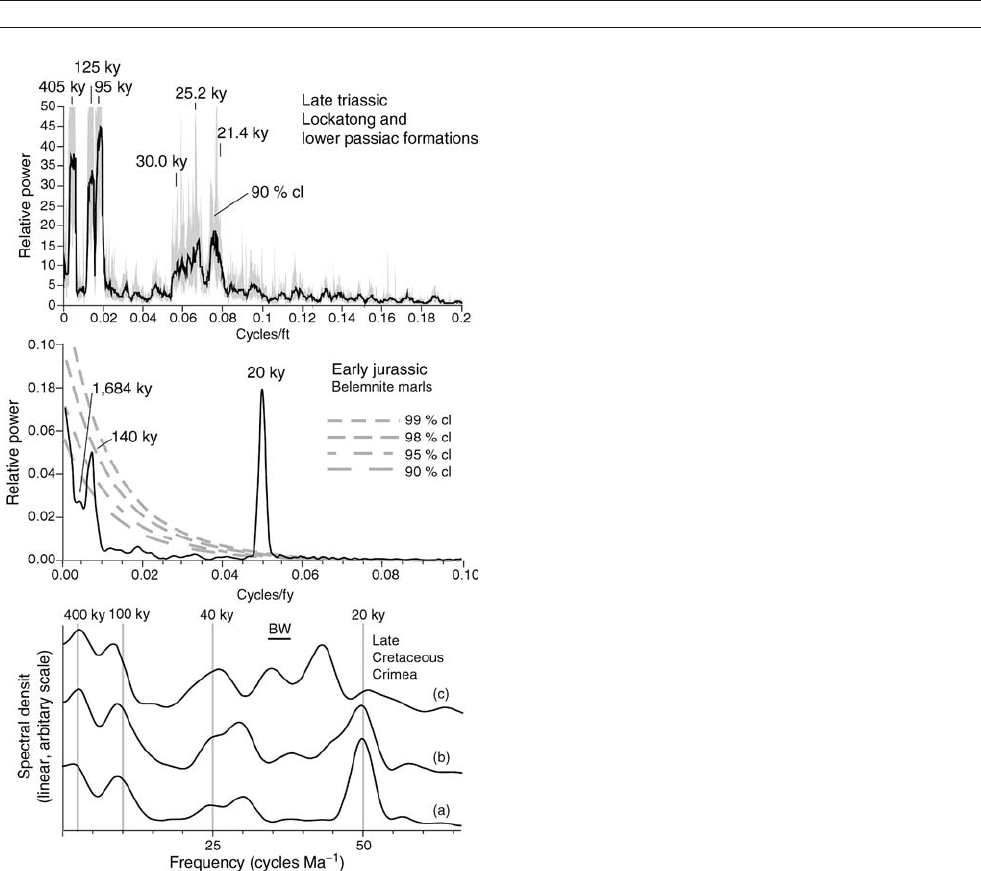
ellipticity of the Earth caused by movement of continents,
mantle, or ice sheets. There should be little measurable change
caused by the chaotic diffusion of the planetary orbits for the
typically cited 405 kyr and 100 kyr eccentricity periods, and
thus the main observable secular change in orbital frequencies
should be in precession.
Many authors have used the canonical 1:5:20 ratio of the
shorter to longer cycles as strong evidence of the Milankovitch
origin of pre-Quaternary cycles, despite uncertainty in the actual
ratio, especially in strata hundreds of millions of years old. In
the absence of any other time constraints, these ratios may not
be unique (e.g., Latemar controversy, see below). Presuming that
the average ratios are broadly consistent with available con-
straints, and the section covers millions of years, evolutive
depth-frequency analysis (as opposed to time-frequency) can
reveal shifts in the absolute values of frequencies through a
section, while maintaining the ratios of the higher to lower
frequencies. Only Milankovitch theory predicts constancy of
those frequencies independent of actual accumulation rate. The
advantage to this analysis is that the changes in accumulation
rate can be derived directly from the spectrogram. At present,
only a few sections have been examined this way (e.g., see
Olsen and Kent, 1999; Preto et al., 2001;Weedon,2003).
The interaction of climatic and sedimentological processes
should produce a distortion of accumulation rates, resulting in
periodograms and time- or depth-frequency spectrograms that
are noisy or distorted beyond interpretation. Two techniques,
gamma analysis (Kominz and Bond, 1990) and frequency mod-
ulation (FM) analysis (Hinnov and Park, 1998) were developed
to deal with a situation in which accumulation rate may be a
function of Milankovitch cycles themselves. Both involve a
version of cycle counting. In gamma analysis, an approximate
solution to the relationship between time and facies is found
for a succession of sedimentary cycles. Individual facies speci-
fic to certain environments are identified within a section and
measured in thickness. Assuming that each cycle is of constant
duration and each facies is characterized by a specific effective
accumulation rate (g), an approximation of the accumulation
rate of each facies can be found by solving a series of simulta-
neous equations representing the cumulative time of the differ-
ent facies within each cycle. The fit of these approximations is
assessed by an inverse method using the accumulation rates
derived from the measured section and Fourier analysis of the
resulting time series. If the accumulation rates are identified
correctly and the sequence is of Milankovitch origin, the Four-
ier spectrum should reflect a better fit to the expectations of
Milankovitch theory than the original data. Although this
method incorrectly assumes a constant duration for the preces-
sional cycles, it might reveal the presence of another cycle to
which the section could be tuned, such as the 40 kyr obliquity
cycle of relatively constant frequency. This method has been
applied to Cambrian marine, and Triassic and Jurassic lacus-
trine sequences, significantly improving the spectral properties
of the data.
FM analysis begins with the identification of the presumed
geological expression of precessional (or obliquity) cycles
and estimation of the length of each cycle, creating a new time
series of depth against cycle thickness. Fourier analysis of this
new time series reveals the FM modulating cycles. Since the
precession cycle is frequency modulated by the “eccentricity”
cycles, FM analysis of a real insolation curve reveals the
eccentricity cycles (see Hinnov, 2000). FM analysis of the data
curve also has this characteristic shape if it is the result of
Milankovitch processes. A tacit assumption of this method is
that there is a strong and amplified link between the frequency
modulators of accumulation rate and the eccentricity cycles
themselves. A major disadvantage to this method is that the
higher frequency cycles must be identified, which is nearly
impossible in noisy, low amplitude, or clipped records. In addi-
tion, the Fourier FM spectral pattern may not be unique to
the frequency band characterized by the “usual” Milankovitch
frequencies; it may be shared with sub-Milankovitch, yet still
quasiperiodic, climatic processes.
Figure P90 Power spectra of pre-Quaternary paleoclimate proxy time
series. Top: Thompson multitaper spectral estimate of 3 million year of
Triassic lake level data (depth ranks) from New Jersey, USA, modified
from Olsen and Kent (1996), shaded area is 90% confidence limits;
middle: discrete Fourier transform power spectrum of 1.7 million year of
wt% CaCO
3
data from the marine Belemnite Marls, England (modified
from Weedon et al., 1999); bottom: linear Blackman Tukey spectral
analysis of grey scale reflectance of a 720 kyr section of Cretaceous
marine strata from the Crimea, Ukraine (from Gale et al., 1999).
PRE-QUATERNARY MILANKOVITCH CYCLES AND CLIMATE VARIABILITY 829
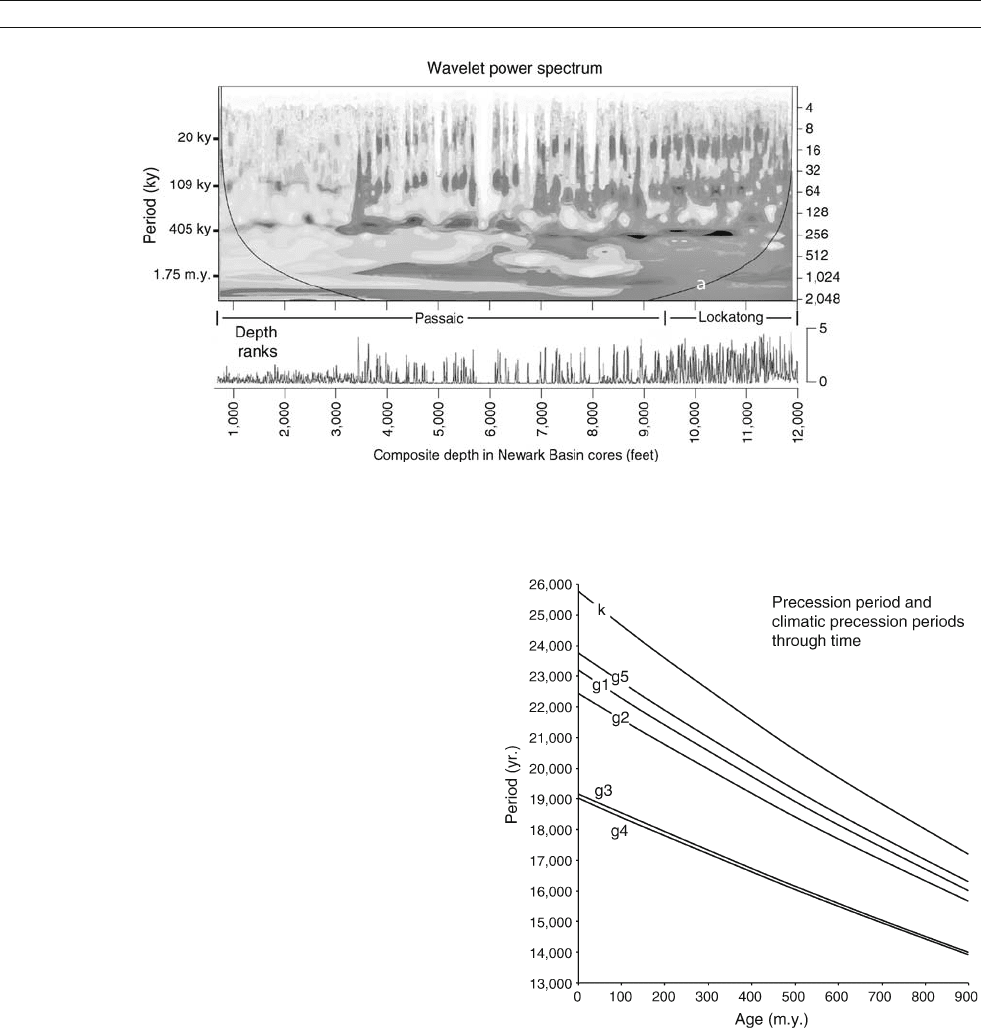
Proxies
Since climate parameters cannot be measured in sedimentary
strata, a reasonably direct recorder of a response to climate
change, or climate proxy, is necessary. For Quaternary sequen-
ces, a vast array of possible climate proxies can be reasonably
calibrated because neither the tectonic plate configuration nor
species composition has changed much over the last 2 million
years. These proxies include d
18
O, a proxy mostly for ice
volume (e.g., Hays et al., 1976), eolian dust, a proxy mainly
for aridity and wind intensity, and pollen and spores, a reflection
of climate-related changes in plant species distributions. Deeper
in time these proxies can be affected by diagenesis, lithification,
and lack of extant taxa that can be calibrated. Proxies less
prone to time-related processes range from sedimentary facies
classifications sensitive to water depth (e.g., Olsen, 1986)to
geochemical proxies such as d
13
C of organic matter, carbonate
sensitive to climate-related oceanographic processes, and oil-
shale yield, related to water depth (e.g., Bradley, 1929).
Examples of pre-Quaternary Milankovitch cycles
Neogene
Largely circum-Mediterranean and deep sea core sections are the
basis of a high resolution Miocene to Quaternary Milankovitch-
cycle-calibrated timescale (Shackleton et al., 1990; Hilgen,
1991b; Hilgen et al., 1995, 1997). The Mediterranean marine
sections exhibit the marl-sapropel cyclicity originally described
from Mediterranean cores. The largest-scale bundles of cycles
visible are matched to the 400 kyr of a precession-dominated
isolation curve, in a portion of the section that is already well
dated. Progressively smaller bundles are matched to the insola-
tion curve, followed by precession-related individual marl-
sapropel cycles (Figure P88). Older sections are then spliced.
The hierarchical nature of both the bundling and the insolation
curve limits potential miscorrelations. Radiometric dates have
been used to test the timescale. The astronomical calibration is
so robust that it has allowed for a recalibration of the
40
Kdecay
constant, itself (Hilgen et al., 1999) now widely adopted.
Hilgen’s method has also been extended to non-marine strata,
particularly in the Miocene (Aziz et al., 2003).
Shackleton et al. (1999, 2000), Palike et al. (2004), and
Billups et al. (2004) have used marine cores showing strong
Figure P91 Evolutive spectral analysis of 22 million year of lake level (depth rank) data from the continuously cored Late Triassic age lacustrine
Lockatong and Passaic formations of the Newark Rift basin, New Jersey, USA. Above: continuous wavelet transform of lake level data (wavelet
provided by C. Torrence and G. Compo; http://paos.colorado.edu / research/ wavelets/ run by M. Machlus); bottom: depth rank data in depth domain
(from Olsen and Kent, 1996).
Figure P92 Change in the period of the Earth’s axial precession due to
tidal friction over the last 900 million years, and the expected changes
in climatic precessional cycles. The sum of the frequency of axial
precession, k, and the various fundamental frequencies of the planets,
g1–g5 (only the most important 5 shown here) is equal to the
frequency of climatic precession. For the present day, there is a cluster
of 3 periods around 23 kyr and another 2 periods around 19 kyr.
Derived from Berger et al. (1992).
830 PRE-QUATERNARY MILANKOVITCH CYCLES AND CLIMATE VARIABILITY
